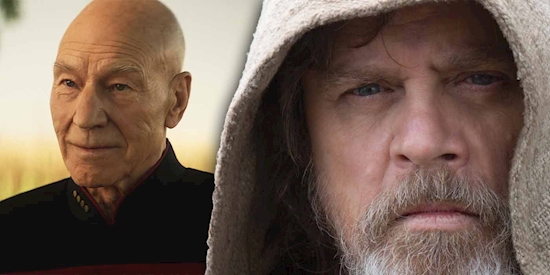Ever Hopeful, Star Trek & Star Wars Suddenly Turn to the Post-Apocalypse
Star Trek and Star Wars don't usually have much in common. They're two different flavors of sci-fi that don't mix well, but one thing they do tend to have in common is a hopeful outlook. Star Trek is about a utopian future built on intergalactic cooperation, whereas Star Wars is ultimately about the hero's journey and good triumphing over evil. With that in mind, it's surprising that big projects from both properties are taking a dark turn into exploring apocalyptic events.
Star Trek's apocalypse-like event happens after a catastrophe known as The Burn in Season 3 of Discovery. No one knows how, but The Burn caused Dilithium crystals to go inert, making all of the warp cores they powered explode, and rampant death and destruction followed. With its fleet of starships nearly wiped out, The United Federation of Planets collapsed.
Click the button below to start this article in quick view. Start nowConversely, Star Wars' inciting incident happens in the upcoming publishing initiative, The High Republic, which is similar to The Burn. The Great Disaster, which takes place in 232 BBY (200 years before the Skywalker Saga), caused starships to be abruptly launched out of hyperspace. Consequently, this scatters the passengers, supplies and cargo of the Legacy Runshipthrough the Outer Rim, an uncharted part of the galaxy. The chaos leaves the planets of the Outer Rims vulnerable to space pirates known as the Nihil.
The events do take place at wildly different points in their respective timelines. The High Republic takes place before Star Wars' most familiar setting, while The Burn takes place in the farthest future Trek has ever seen, following a time jump. They are surprisingly similar otherwise, especially for franchises that aren't usually big on apocalyptic events.
The knee-jerk response to any miserabilist turn these days is understandably due to the apocalyptic feel of 2020. While it may make both franchises' apocalyptic stories seem more timely, that likely isn't the reason why they decided to take this darker turn, given that Season 3 of Discovery wasn't affected by COVID-19 until after it was in post-production, and the launch of the first two novels under The High Republic banner was delayed by COVID into 2021.
Of course, it's not as if the world was in great shape before COVID hit. The brain trusts behind Discovery and the High Republic had a lot of anxiety to tap into before a pandemic swept the globe. From the state of politics in the U.S. to the threat of climate change, there's no shortage of ambient dread for creators to draw from.
It easy to understand why Discovery's writers want to explore a world with a diminished Federation, as a utopian society feels more distant than ever, both in the real world and in the Star Trek universe. Additionally, Star Wars' usual battle between the Sith and Jedi needed a break after The Rise of Skywalker. The idea of an oppressive evil being defeated with a lightsaber duel feels overdone, and pitting the Jedi against space pirates instead of Sith is a welcome change of pace.
There are reasons for both projects learning towards darker material beyond the zeitgeist, being that there are many interesting storytelling possibilities that can come from these inciting incidents. Both the new season of Discovery and The High Republic give the creative teams a chance to explore fresh timelines in their perspective franchises. Discovery takes place in a future Trek fans have never seen. The High Republic carves out a new space for itself in the Star Wars canon, firmly between the Old Republic time period and the Skywalker Saga. The importance of novelty in long running franchises can't be overstated.
Disney, in particular, finally has a chance to break away from established Star Wars lore and create a setting that they can make their own. The High Republic time period has never been explored in any Star Wars media, not even the years of the Extended Universe stories that are now part of the non-canon Legends continuity.
The move towards a fresh setting can also be seen as a way of both franchises shaking off J.J. Abrams' influence. Abrams' Star Trek movies raised the stakes of their stories to include the destruction of planets. Discovery and Picard both followed in Abrams' films footsteps by making planetary destruction part of their recent seasons. However, The Burn changes the stakes entirely and gives Michael Burnham a new mission. It also gives Discovery's writers freedom from the canon they had to adhere to in the show's previous time period ten years before the original series.
The High Republic's setting and inciting incident allows its writers to play with genre in the Star Wars Universe. The author of the first book in the series, Charles Soule, has said that his "personal mandate" for The High Republic is to take Star Wars in new directions. His novel, Light of the Jedi, will fittingly use the Great Disaster to tell a dystopian inspired Star Wars story.
As much as the disasters in the Discovery and The High Republic might feel like trend hopping, they go deeper than that, giving the two franchises a new storytelling direction. Writers get a chance to tell stories that deviate from franchise norms, while fans get a chance to explore new corners of beloved universes. The introduction of the respective universes' use of apocalyptic events may seem grim, but it could lead to a bright future for both of sci-fi's most venerable franchises.
About The AuthorSource: www.cbr.com

